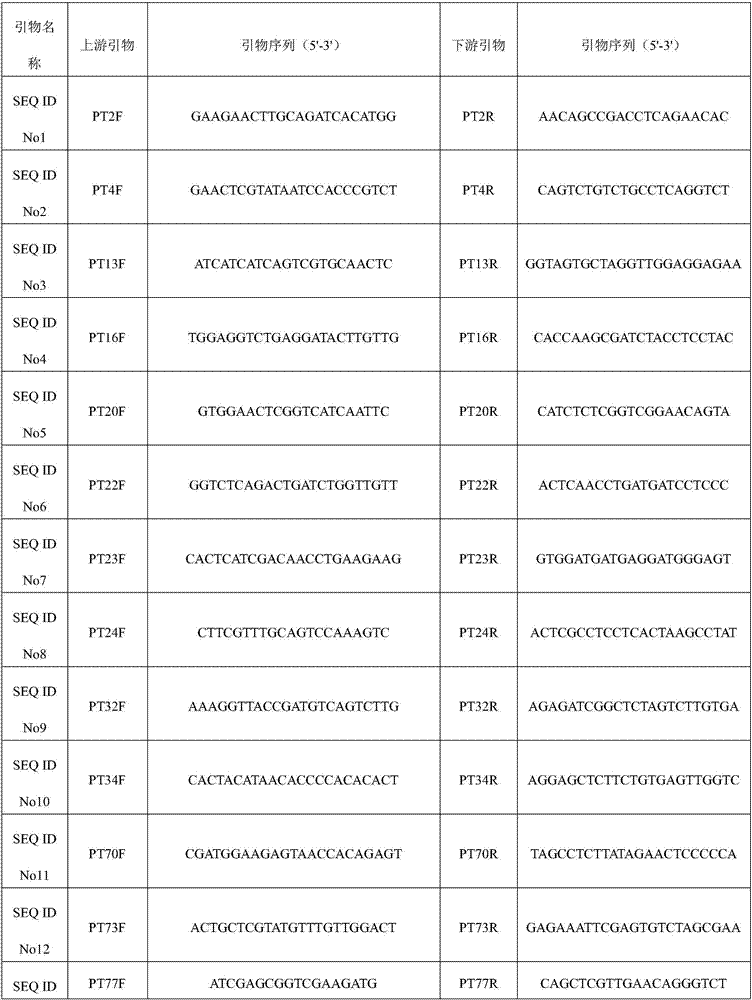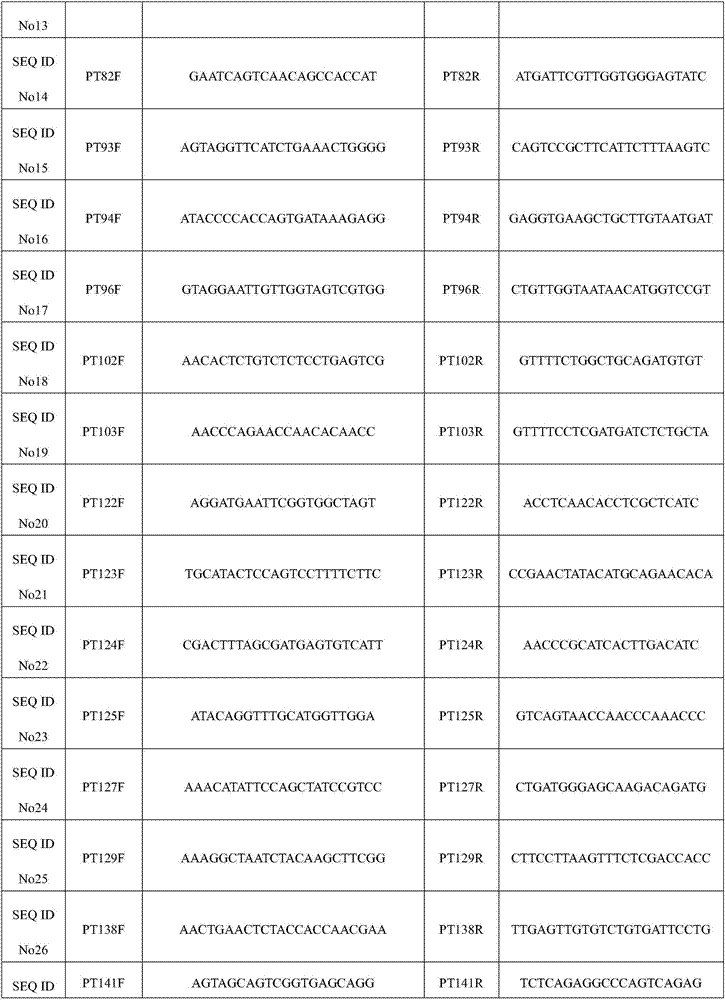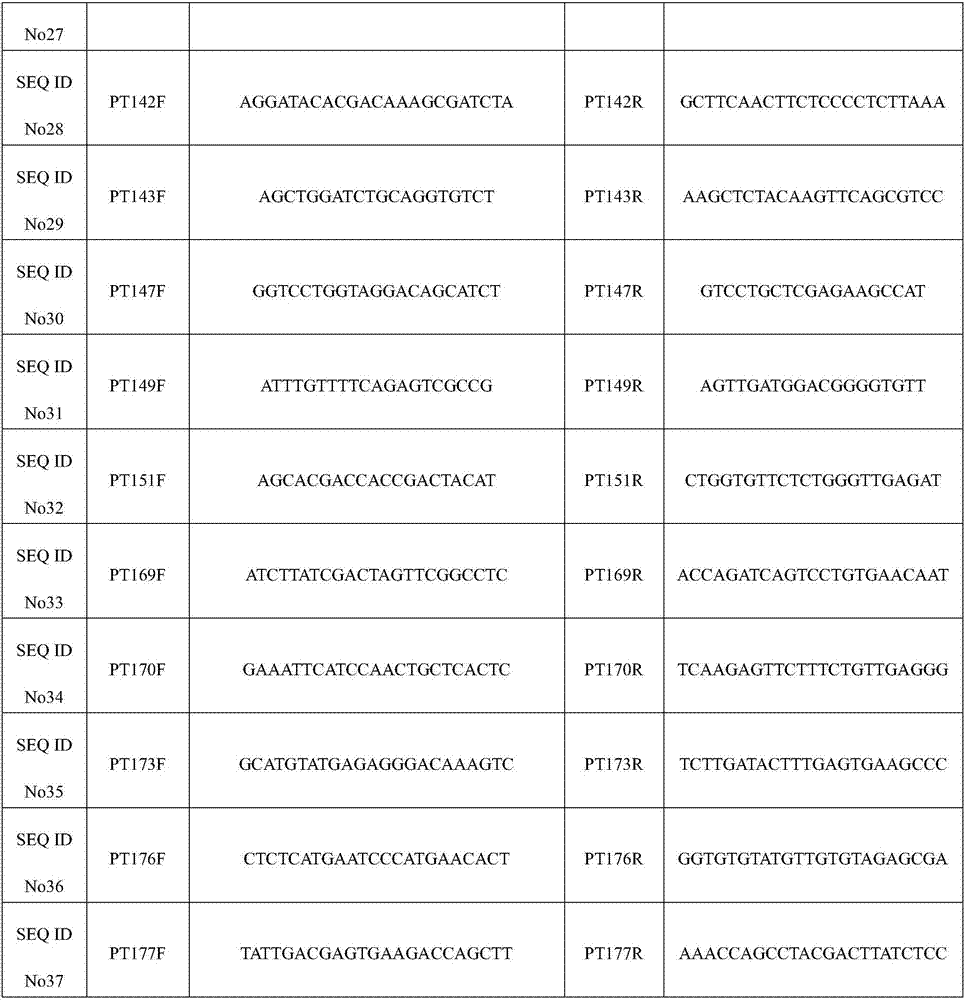Primer set of puccinia recondita tritici EST-SSR molecular marker, detection method and application thereof
A technology of wheat leaf rust and molecular markers, applied in biochemical equipment and methods, microbial measurement/testing, recombinant DNA technology, etc., can solve the problems of cumbersome steps, strong randomness, and difficult conditions to control, and achieve simple operation , convenient detection, and stable PCR amplification results
- Summary
- Abstract
- Description
- Claims
- Application Information
AI Technical Summary
Problems solved by technology
Method used
Image
Examples
Embodiment 1
[0043] Acquisition of RNA-seq data of wheat leaf rust and synthesis of EST-SSR primers
[0044] The RNA of wheat leaf rust was extracted, and the samples were submitted to Huada (Shenzhen) Company for RNA-Seq sequencing.
[0045] Through sequencing and assembly on the Illumina Hiseq2000 platform, 46,008 Unigenes were obtained from Pythora tritici, and the N50 reached 1,064 nt; using MISA software to search for SSR sites from the 46,008 Unigene sequences, a total of 3,729 SSR sites were obtained, distributed in 3,085 In Unigenes; Primer3 software was used to design primers, and 37 pairs of primer sequences were randomly selected and synthesized by Shanghai Sangon Bioengineering Co., Ltd. Primer sequences are shown in Table 3.
[0046] Table 3 Sequence information of 37 pairs of primers
[0047]
[0048]
Embodiment 2
[0050] Extraction of whole genome DNA of wheat leaf rust
[0051] 1) Weigh about 200 μg of ureterospores of wheat leaf rust, put them in 2mL centrifuge tubes, put them into a liquid nitrogen pot for pre-cooling, and grind them fully with a tissue grinder;
[0052] 2) Quickly add 800 μL of 65°C preheated CTAB solution (add 2% mercaptoethanol before use) to the centrifuge tube, put the centrifuge tube in a 65°C water bath for 1 hour, and mix the sample by inverting every 5 minutes during this period;
[0053] 3) After cooling to room temperature, add 800 μL of phenol: chloroform: isoamyl alcohol (25:24:1), mix well for 10 minutes, and then centrifuge at 12000 rpm for 15 minutes;
[0054] 4) Aspirate the supernatant, put it into a new centrifuge tube, add 800 μL of chloroform:isoamyl alcohol (24:1), mix for 10 minutes, and then centrifuge at 12000 rpm for 10 minutes;
[0055] 5) Transfer the supernatant to a new tube, add 1 mL of -20°C pre-cooled anhydrous ethanol, mix well, and p...
Embodiment 3
[0060] The amplification system is: 2 μL of template DNA, 1 U of Taq DNA polymerase, 1.0 mmol / L of dNTPs, 1.5 μL of upstream and downstream primers, 1×PCR Buffer in a 25 μL total system, and the rest is supplemented with sterile distilled water to 25.0 μL.
[0061] The reaction program was: pre-denaturation at 94°C for 5 min, followed by denaturation at 94°C for 30 s, annealing at 55-59°C for 1 min, extension at 72°C for 1 min, and 35 cycles, and finally extension at 72°C for 2 min, and storage at 10°C.
[0062] The detection method is as follows: take 5 μL of the amplified product, add 0.5 μL of denatured sample loading indicator, and separate it by electrophoresis in a polyacrylamide gel with a concentration of 10%. Silver staining.
PUM
 Login to View More
Login to View More Abstract
Description
Claims
Application Information
 Login to View More
Login to View More - R&D
- Intellectual Property
- Life Sciences
- Materials
- Tech Scout
- Unparalleled Data Quality
- Higher Quality Content
- 60% Fewer Hallucinations
Browse by: Latest US Patents, China's latest patents, Technical Efficacy Thesaurus, Application Domain, Technology Topic, Popular Technical Reports.
© 2025 PatSnap. All rights reserved.Legal|Privacy policy|Modern Slavery Act Transparency Statement|Sitemap|About US| Contact US: help@patsnap.com



